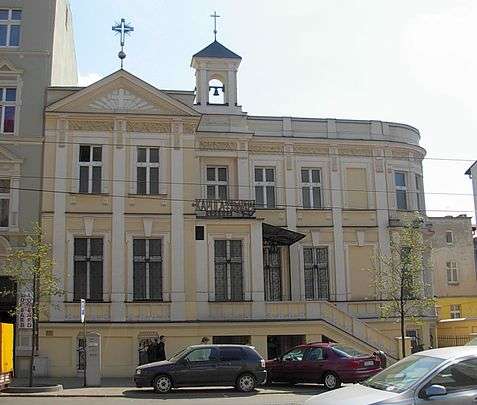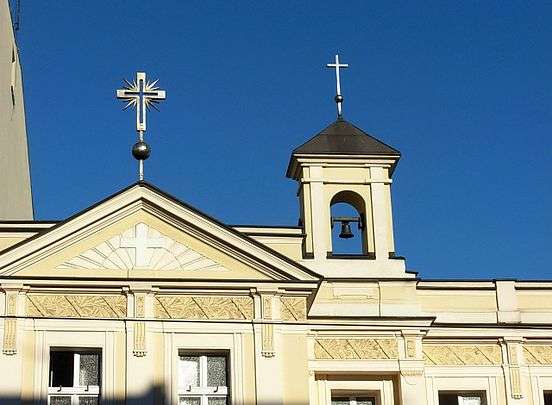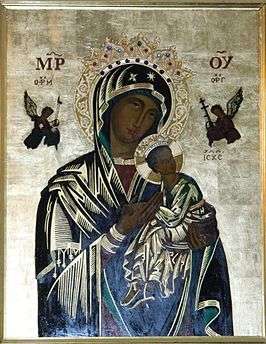Chapel of the Sisters of the Poor Clares, Bydgoszcz
| Chapel of the Sisters of the Poor Clares | |
|---|---|
| Public chapel of the Poor Clares of Perpetual Adoration | |
| Polish: Kaplica sióstr Klarysek pw. Bożego Ciała w Bydgoszczy | |
 View from Gdanska Street | |
 Chapel of the Sisters of the Poor Clares Location within Poland | |
| 53°7′51″N 18°0′32″E / 53.13083°N 18.00889°ECoordinates: 53°7′51″N 18°0′32″E / 53.13083°N 18.00889°E | |
| Location | Bydgoszcz |
| Country | Poland |
| Denomination | Catholic |
| Churchmanship | Latin Church |
| Website |
(Polish) bydgoszcz |
| History | |
| Dedication | Eucharist |
| Consecrated | 1925 |
| Architecture | |
| Architectural type | Modern architecture |
| Years built | 1900-1901 |
| Wikimedia Commons has media related to Corpus Christi chapel in Bydgoszcz. |
The Chapel of the Sisters of the Poor Clares is a church in downtown Bydgoszcz.
Location
The church stands on eastern side of Gdańska street, at N°56.
History
Predecessors of the Sisters of the Poor Clares in Bydgoszcz were the sisters of the Order of Poor Clares. They came to Bydgoszcz in 1615 and stayed until secularization of the Order by Prussian authorities in 1835. This congregation left several monastic buildings in the urban landscape of Bydgoszcz, still visible today:
- the hospital and shelter edifice, now operated by the Regional Museum department;
- the Gothic and renaissance Poor Clares' Church.
The sisters Poor Clares of Perpetual Adoration came to Bydgoszcz in 1925: it was not the congregation from the 17th to 19th centuries, but its younger branch, whose mission is a constant adoration of Jesus Christ through Blessed Sacrament of Eucharist.
The present building of the chapel was built in 1900-1901, designed as a residential villa belonging to Adolf and Emil Kolwitz,[1] a famous Prussian merchant,[2] co-owner of a warehouse, "Ludwig Kolwitz", in Chodkiewic street. The chapel was built in the yard.
In 1925, the plot was sold to the congregation of the Poor Clares of Perpetual Adoration from Gniezno and a building was rebuilt on the place. The dedication of the chapel happened on September 14, 1925, during a ceremony chaired by Bishop Antoni Laubitz. Then started the perpetual Eucharistic adoration. The day-long adoration students attended school in Bydgoszcz and were residents of the city.
On September 13, 1939, Nazi troops entered the monastery, arrested the chaplain and locked the chapel. On July 7, 1941, the sisters were forced to leave the monastery, while Nazis had offices built in the premises. One of the sisters, Maria Kaminska Kaleta, was murdered in 1944.
After the liberation of Bydgoszcz, the chapel billeted Soviet troops from January to June 1945, then the building was initially allocated to the Tax Chamber office of Pomerania. However, thanks to the tireless efforts of the sisters, they regained back their building from July 22, 1945. The reorganization of the monastery after World War II ended on February 16, 1946, when lifetime adoration resumed inside the edifice.
On September 29, 1986, Cardinal Józef Glemp has consecrated the new altar in the chapel. The current public chapel is located in a former villa.[3]
Architecture
The initial building was built in the style of the early modernism with elements of neo-classicism. In 1925, during the reconstruction, the interior has been decorated to fit chapel's requirements, and the facade has been adorned with a small cross and a bell. On November 22, 1953, has been unveiled the sacrated image ofOur Lady of Perpetual Help by Father Kazimierz Hołda.
Gallery
 Detail on the top of the facade
Detail on the top of the facade- Interior
 Our Lady of Perpetual Help
Our Lady of Perpetual Help
See also
- Poor Clares of Perpetual Adoration
- Poor Clares' Church, Bydgoszcz
- Gdanska Street in Bydgoszcz
- (Polish) Downtown district in Bydgoszcz
Bibliography
- (Polish) Pawęzka Zofia. Siostry Klaryski. In. Kalendarz Bydgoski 2001
- (Polish) Ulica Gdańska w Bydgoszczy – przewodnik historyczny. Praca zbiorowa. Wojewódzki Ośrodek Kultury w Bydgoszczy 2003
References
- ↑ "Names". Adressbuch nebst allgemeinem Geschäfts-Anzeiger von Bromberg und dessen Vororten auf das Jahr 1901: auf Grund amtlicher und privater Unterlagen. Bromberg: Dittmann. 1901. p. 94.
- ↑ The Kolwitz family had a charitable foundation that helped supporting Diakonisek Hospital in Poznań. In recognition, in 1906 a street in Bielawa received his name.
- ↑ Bydgoszcz Guide. Bydgoszcz: City of Bydgoszcz. July 2014. p. 103. ISBN 83-917786-7-3.